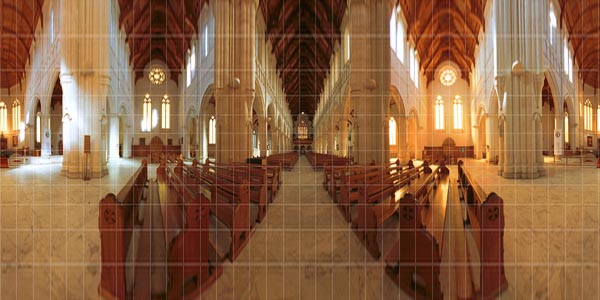Difference between revisions of "Cylindrical Projection"
(copyedit) |
(cyl. projection can show > 360 deg. horizontally) |
||
| (One intermediate revision by one other user not shown) | |||
| Line 1: | Line 1: | ||
| + | {{Glossary|A projection capable of mapping 360 degrees horizontally by roughly 120 degrees vertically with acceptable distortion.}} | ||
[[image:big ben cylindrical.jpg|right|Cylindrical projection, with permission from Ben Kreunen]] | [[image:big ben cylindrical.jpg|right|Cylindrical projection, with permission from Ben Kreunen]] | ||
A '''cylindrical projection''' is a type of [[Projections|projection]] for mapping a portion of the surface of a sphere to a flat image. It can be envisioned by imagining wrapping a flat piece of paper around the circumference of a sphere, such that it is tangent to the sphere at its equator. Shining a light from the center of the sphere then projects the spherical surface onto the flat paper. | A '''cylindrical projection''' is a type of [[Projections|projection]] for mapping a portion of the surface of a sphere to a flat image. It can be envisioned by imagining wrapping a flat piece of paper around the circumference of a sphere, such that it is tangent to the sphere at its equator. Shining a light from the center of the sphere then projects the spherical surface onto the flat paper. | ||
| − | In panoramic imaging, the cylindrical projection is most often used for prints of wide panoramas which occupy large range (>120 degrees) of longitude. Like the [[Equirectangular Projection]], the cylindrical projection also preserves verticals, but it cannot represent data near the poles ([[nadir]] and [[zenith]]), which are distorted and stretched further and further to infinity. | + | In panoramic imaging, the cylindrical projection is most often used for prints of wide panoramas which occupy large range (>120 degrees) of longitude. Like the [[Equirectangular Projection]], the cylindrical projection also preserves verticals, but it cannot represent data near the poles ([[nadir]] and [[zenith]]), which are distorted and stretched further and further to infinity. It can however be used to display more than 360 degrees horizontally: scanning cameras often record a little bit more than 360 degrees so the overlapping region is easier to be stitched if light changes or something moves in that area. Multiples of 360 degrees can e.g. display a changing subject like different seasons. |
Straight lines which are not vertical in reality become curved (other than the horizon). The horizon is mapped to a straight line across the middle of the image. Of course this only applies if the axis which the camera was rotated around was strictly vertical. If not the horizon is curved. | Straight lines which are not vertical in reality become curved (other than the horizon). The horizon is mapped to a straight line across the middle of the image. Of course this only applies if the axis which the camera was rotated around was strictly vertical. If not the horizon is curved. | ||
Revision as of 13:10, 19 February 2008
A cylindrical projection is a type of projection for mapping a portion of the surface of a sphere to a flat image. It can be envisioned by imagining wrapping a flat piece of paper around the circumference of a sphere, such that it is tangent to the sphere at its equator. Shining a light from the center of the sphere then projects the spherical surface onto the flat paper.
In panoramic imaging, the cylindrical projection is most often used for prints of wide panoramas which occupy large range (>120 degrees) of longitude. Like the Equirectangular Projection, the cylindrical projection also preserves verticals, but it cannot represent data near the poles (nadir and zenith), which are distorted and stretched further and further to infinity. It can however be used to display more than 360 degrees horizontally: scanning cameras often record a little bit more than 360 degrees so the overlapping region is easier to be stitched if light changes or something moves in that area. Multiples of 360 degrees can e.g. display a changing subject like different seasons.
Straight lines which are not vertical in reality become curved (other than the horizon). The horizon is mapped to a straight line across the middle of the image. Of course this only applies if the axis which the camera was rotated around was strictly vertical. If not the horizon is curved.
Cylindrical projection is the native output format of a rotating (scanning) panorama camera (like panoscan, spheron and others) with rectilinear lens or from a swing lens camera (Horizon, Noblex...)
Other forms of cylindrical projections which can represent the poles, such as the Mercator Projection common in map-making, are not typically used in panoramic imaging.
External links
- Cylindrical projection at Mathworld shows an example and gives details on the mathematics
